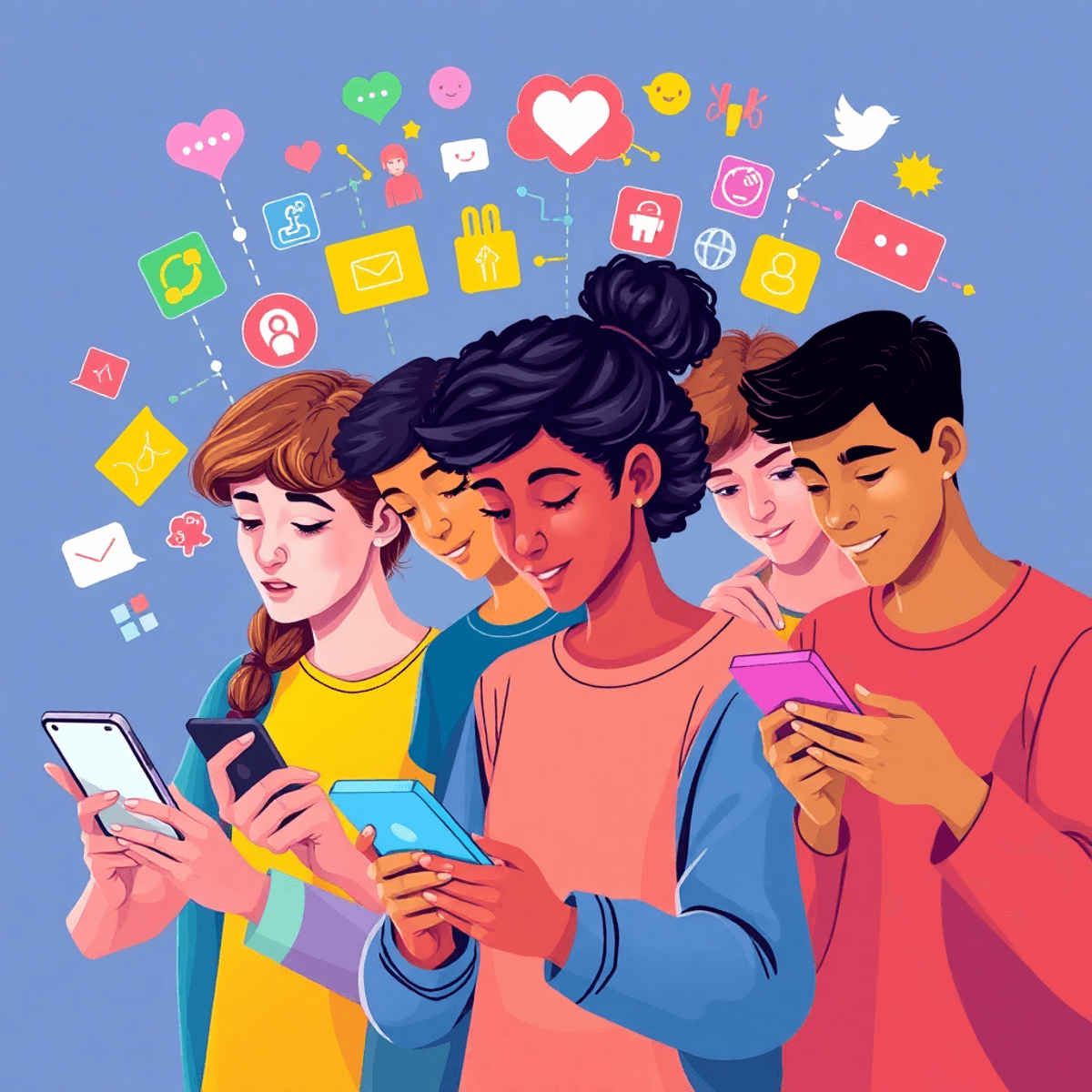In 2025, social media has become an inseparable part of our lives, revolutionizing the way we connect, share, and perceive ourselves. With 93% of teenagers actively using these platforms, the relationship between social media and mental wellbeing has grown increasingly intricate.
The effects of social media on mental health are contradictory. While these platforms provide valuable opportunities for connection and self-expression, they have also contributed to a troubling decline in adolescent mental wellbeing. Recent studies reveal that 1 in 4 young people aged 17-19 now face probable mental health conditions – a statistic that requires our immediate attention.
The evolution of social media platforms has dramatically shifted from simple communication tools to sophisticated ecosystems that shape our psychological experiences. Today’s platforms use advanced algorithms and engaging features that trigger dopamine release, creating potentially addictive behavioral patterns.
Understanding this impact is crucial for:
- Parents navigating their children’s digital lives
- Educators developing effective support systems
- Healthcare professionals treating mental health conditions
- Policymakers crafting protective regulations
- Young people managing their own online experiences
As we witness this digital transformation, the need to balance social media’s benefits with its potential risks has never been more critical. The decisions we make today about how we use and regulate these platforms will shape the mental health landscape for generations to come.
In the midst of this digital landscape, it’s important to remember that mental wellbeing isn’t solely influenced by social media. Factors such as diet and lifestyle choices also play significant roles. For instance, certain medications like Ozempic, commonly used for weight management, can have profound effects on our physical health and indirectly influence our mental state. Understanding the science behind prolonged satiety after meals while on Ozempic can provide valuable insights into how our dietary habits affect our overall wellbeing.
However, it’s crucial to be aware of the potential side effects of such medications. Ozempic has been linked to some serious gastrointestinal side effects, including bowel injuries, which are important considerations for anyone using this medication.
Moreover, lifestyle changes such as intermittent fasting, have been shown to significantly influence metabolic health and could be an alternative approach for those struggling with weight management.
Additionally, personal health decisions can also intersect with social media usage. For example, the decision to undergo Testosterone Replacement Therapy (TRT) can impact men’s health in various ways, including aspects related to mental wellbeing.
Lastly, it’s worth noting that certain medications may not be safe during specific life stages. For instance, Ozempic is not considered safe during pregnancy, which is an important factor for women who are considering this medication while expecting.
As we navigate the complexities of social media and its impact on mental health, let us not forget the importance of holistic wellness that encompasses
Current Landscape of Adolescent Mental Health Trends
Adolescent mental health has seen a significant decline over the past decade. Recent statistics highlight the gravity of this issue, as reported by UNICEF, which reveals that 1 in 6 children aged 7-16 and 1 in 4 young people aged 17-19 in the UK have probable mental health conditions such as depression, anxiety, and disordered eating.
This increasing prevalence underscores the urgency for intervention. Nearly half of individuals with mental health conditions experience symptoms before age 18, which emphasizes the need for early detection and support strategies. Understanding these trends is crucial in addressing adolescent mental health and developing effective interventions. The World Health Organization also stresses the importance of focusing on this demographic’s health.
However, it’s also essential to consider that factors like nutrition and hydration play a significant role in overall health and wellness, including mental health. For instance, exploring menopause-friendly nutrition could provide insights into dietary changes that might alleviate some mental health symptoms.
Furthermore, proper hydration has been shown to impact cognitive performance and overall wellness, which are critical aspects of mental health.
In addition to these factors, it’s important to remember that women’s health issues can also influence mental well-being. Staying informed on women’s health can empower individuals with insights and tips for better overall wellness.
The Role of Social Media in Shaping Adolescent Experiences
Adolescents in 2025 are nearly universally connected—93% of teens aged 12-17 report having at least one social media profile. Platforms like Instagram, Snapchat, TikTok, and newer networks dominate their daily routines, shaping how they communicate, form identities, and navigate friendship groups. The line between online and offline life is blurred; group chats, trending challenges, and digital storytelling drive much of their social interaction.
Psychological mechanisms at play:
- Social media platforms are engineered to maximize engagement. Each like, comment, or notification triggers a dopamine release in the brain—a reward that reinforces checking and posting behaviors.
- This cycle can lead to excessive use, with many teens reporting several hours per day spent scrolling or interacting online. The design encourages habitual checking, sometimes at the expense of sleep or face-to-face activities.
FOMO—Fear of Missing Out—remains a powerful motivator:
- Constant updates fuel anxiety about being excluded from events or conversations.
- Teens often describe a compulsive need to stay updated so they don’t miss viral moments or opportunities for social validation.
The cumulative effect is heightened vulnerability to addictive behaviors and emotional swings tied to online interactions. For many adolescents, the quest for digital connection becomes inseparable from self-esteem and daily decision-making.
However, the impact of this digital lifestyle isn’t limited to mental health; it can also manifest physically. For instance, excessive screen time and stress from social media can lead to various health issues including gut problems, such as Intestinal Methanogen Overgrowth (IMO) which is often linked with constipation. It’s crucial for adolescents to adopt effective stress management techniques alongside their online activities. Holistic practices such as mindfulness and physical activity can help maintain a balanced well-being amidst the pressures of social media.
Positive Aspects: Connecting and Expressing Through Social Media
Social media platforms in 2025 offer significant benefits for adolescent mental wellbeing, particularly in building meaningful connections. Research shows 74% of teens view these platforms as powerful tools for fostering friendships and maintaining relationships.
Creative Expression and Identity Development
- Digital art sharing communities enable teens to showcase their talents
- Video creation platforms help young people develop storytelling skills
- Personal blogs allow adolescents to find their unique voice
- 63% of teens report enhanced creativity through social media engagement
Support Systems and Community Building
- Virtual support groups connect teens with similar experiences
- Black teens report higher levels of acceptance in online spaces
- LGBTQ+ youth find safe spaces for self-expression
- Shared interests bring together teens from diverse backgrounds
Crisis Support and Mental Health Resources
- Peer support networks provide immediate emotional assistance
- Mental health professionals offer guidance through social platforms
- Anonymous platforms allow teens to seek help without stigma
- Real-time crisis intervention through dedicated social channels
These digital spaces create opportunities for authentic connection and self-discovery. Teens build lasting friendships, share their struggles, and celebrate achievements together. The platforms’ ability to transcend geographical boundaries enables young people to find their tribe, regardless of their physical location.
Moreover, the positive experiences that adolescents encounter on these platforms can significantly influence their overall health. For instance, positive childhood experiences foster well-being and resilience against adversity, which aligns with the supportive nature of these digital spaces.
Negative Impacts: Risks and Challenges Faced by Adolescents Online
Social media’s increasing presence brings a set of risks that directly affect adolescent mental wellbeing. Persistent exposure to curated content and the pressure to maintain an appealing digital persona contribute to heightened rates of depression, anxiety, and loneliness among teens. Studies in 2025 point to a clear trend: heavy social media usage is closely associated with negative mental health outcomes.
Key challenges include:
- Cyberbullying: Online harassment occurs at alarming rates, with many teens encountering hurtful messages, exclusion, or targeted rumors. Cyberbullying’s persistent nature—unlike traditional bullying—follows adolescents into their homes and personal spaces, intensifying feelings of isolation and distress.
- Feelings of Inadequacy: Constant comparison with peers, influencers, and celebrities fosters unrealistic standards regarding appearance, lifestyle, and achievement. Many adolescents report feeling “not good enough” after scrolling through their feeds. This can lead some to explore extreme measures for weight management or altering their appearance, such as comparing options like Phentermine vs. Ozempic, which are medications used for weight management.
- Pressure to Curate: The need to post popular or “like-worthy” content can lead to compulsive self-editing, staged photos, and filtered realities. This drive for validation erodes authenticity and increases social anxiety.
Girls frequently report stronger negative effects tied to confidence and sleep quality, while boys also experience frustration and exclusion. Teens navigating these platforms without strong support systems are especially vulnerable to the cumulative effects of these digital pressures.
In some instances, adolescents may seek out quick fixes for their anxiety or depressive symptoms. It’s worth noting that treatments such as Ketamine, have been explored for anxiety relief with varying results. However, it’s crucial to approach such treatments with caution and under professional guidance.
Additionally, the unrealistic standards set by social media can sometimes lead to unhealthy practices like extreme dieting or fasting. For instance, some may consider a 96-hour fast as a means to achieve rapid weight loss. While fasting can have benefits when done safely, it also carries risks that should not be overlooked.
Lastly, the pressure from social media can also lead to a decline in overall health which some might attempt to counteract with NAD+ injections for anti-aging or cognitive enhancement purposes. If considering such options, it’s essential to understand the ideal NAD+ injection dosage per day for safety and effectiveness.
Understanding Variations: Online Behaviors Among Adolescents With Different Mental Health Conditions
Adolescents with internalizing conditions such as depression and anxiety often exhibit distinct online behaviors compared to their peers. They tend to engage heavily in social comparison and monitoring feedback, but may shy away from honest self-disclosure or authentic self-presentation. This pattern can exacerbate feelings of inadequacy and loneliness.
Those with externalizing conditions like ADHD display different online habits. They generally spend more time on social media but report less control over their usage. This lack of regulation can lead to impulsive behaviors and difficulties in concentrating on other activities.
Comparative Analysis
Internalizing Conditions:
- Higher engagement in social comparison
- Frequent monitoring of feedback
- Less authentic self-presentation
Externalizing Conditions:
- Increased time spent online
- Lower perceived control over social media use
When comparing these groups to adolescents without mental health conditions, several differences emerge. Those without such conditions typically experience fewer negative impacts from social media use and have more balanced online-offline interactions. Social support and stigma play crucial roles, as adolescents with mental health issues often seek validation online, which can further entrench them in unhealthy digital patterns.
Understanding these variations is essential for developing targeted interventions that address the unique needs of each group, fostering healthier online behaviors and improving overall mental wellbeing.
In addition to addressing online behaviors, it’s also important to consider other aspects of health such as diet and exercise. For instance, building a balanced diet can significantly contribute to overall well-being, including mental health. Similarly, regular exercise has been shown to have numerous benefits for mental health, helping to alleviate some symptoms associated with both internalizing and externalizing conditions. Furthermore, understanding medication options like Jardiance vs. Ozempic, which are used in managing conditions such as Type 2 diabetes that may co-exist with mental health issues, can also be beneficial for adolescents navigating these challenges.
Parental Perspectives: Balancing Concerns and Realities
Parental perspectives on the impact of social media on their children’s mental health often differ significantly from those of adolescents. Many parents express heightened concern about the potential negative effects, citing issues such as depression, anxiety, and sleep disturbances. These worries are not unfounded; statistics show an alarming rise in mental health problems among teens over the past decade.
Parents’ Viewpoint
Parents frequently blame social media as a primary factor contributing to these issues. This perspective is supported by research linking excessive social media use to various mental health challenges. However, it is crucial to consider other contributing factors like academic pressure, family dynamics, and socioeconomic conditions that also play significant roles.
Teens’ Viewpoint
Teens, on the other hand, might acknowledge some negative aspects but often emphasize the positive experiences gained through social media, such as connection with peers and creative expression. This divergence in views can create a gap in understanding between parents and children.
Understanding Coping Mechanisms
Moreover, it’s essential for parents to understand that some teens may resort to unhealthy coping mechanisms such as excessive drinking or poor dietary choices due to stressors from social media or academic pressure. For instance, if a teen is using medications like Wegovy for weight management, they need to be informed about how Wegovy interacts with alcohol which could have serious implications on their health.
Finding Common Ground
By acknowledging both sets of perspectives and considering multiple influencing factors, a more balanced approach to managing social media use can be achieved. This includes fostering open communication between parents and teens about online experiences and developing strategies that address holistic mental wellbeing.
Recommendations for Healthy Social Media Use Among Adolescents
Practical Suggestions for Reducing Use Time
To improve mental wellbeing outcomes like anxiety and depression, reducing overall social media use time is crucial. Adolescents can implement the following strategies:
- Track Time Spent Online: Utilize apps that monitor and limit daily usage.
- Disable Notifications: Reducing the constant prompts to check phones can decrease habitual use.
- Limit App Checks: Schedule specific times for social media, avoiding constant engagement.
- Turn Off Phones During Activities or Overnight: This not only ensures better focus on tasks but also improves sleep quality. For tips on how to enhance your sleep and relaxation, consider visiting our Sleep & Relaxation Archives.
- Gradually Remove Apps: Start with less-used apps to ease the transition.
Strategies for Responsible Usage
Prioritizing authenticity over validation helps create a healthier relationship with social media. Consider these approaches:
- Engage Actively, Not Passively: Participate in meaningful interactions rather than passive scrolling.
- Focus on Offline Friendships: Strengthen face-to-face interactions to enhance happiness and mental health.
- Adjust Privacy Settings: Maintain control over who sees your content and reduce exposure to potential negativity.
- Educate About Unrealistic Portrayals: Understand that many online posts are curated, not necessarily reflective of real life.
- Promote Offline Interests: Encourage activities like exercise or hobbies that don’t involve screens.
These practices empower adolescents to use social media responsibly, fostering a balanced digital life that supports their mental wellbeing. Additionally, promoting healthy eating habits such as incorporating healthy snacks can further enhance overall wellbeing.
Conclusion
Social media’s influence on mental wellbeing in 2025 presents both opportunities and challenges. The digital landscape offers unprecedented connectivity, creative expression, and support networks. Yet these benefits come with significant risks to mental health, particularly for vulnerable adolescents.
The path forward requires a balanced, collaborative approach:
- Parents must actively engage in their children’s digital lives through open dialogue and consistent monitoring
- Educators need to integrate digital literacy and mental health awareness into their curricula
- Policymakers should implement evidence-based regulations protecting young users
- Tech companies must prioritize user wellbeing over engagement metrics
Moreover, it’s essential to recognize that the impact of social media on mental health can also extend to physical health. For instance, while switching from Jardiance to Ozempic may be a consideration for some individuals, the stress and anxiety induced by negative online experiences can exacerbate existing health issues.
Similarly, the pressure to conform to certain beauty standards propagated by social media can lead to unhealthy skincare practices. However, understanding the latest breakthroughs in skincare technology can empower young people to make informed choices about their beauty routines rather than succumbing to harmful trends.
The future of adolescent mental health depends on our collective ability to foster healthy digital habits. By working together, we can create an online environment where young people thrive while maintaining their mental wellbeing. The time to act is now – our children’s psychological health hangs in the balance.
FAQs (Frequently Asked Questions)
What is the relationship between social media and adolescent mental wellbeing in 2025?
In 2025, social media continues to significantly influence adolescent mental wellbeing, with both positive and negative effects. Understanding this relationship is crucial as social media platforms evolve, impacting mental health trends among teens and society at large.
How has adolescent mental health changed over the past decade, particularly in 2025?
Adolescent mental health has declined over the past decade, with rising prevalence rates of probable mental health conditions such as depression, anxiety, and disordered eating in 2025. Early onset of symptoms before age 18 highlights the need for timely intervention strategies.
What are the psychological mechanisms behind excessive social media use among adolescents?
Excessive social media use among adolescents is driven by psychological mechanisms like dopamine release associated with addictive behaviors and the fear of missing out (FOMO), which compels teens to engage frequently with social media platforms.
What positive impacts does social media have on adolescent mental wellbeing?
Social media fosters friendships, creativity, acceptance, and support among adolescents. It provides a platform for self-expression and a sense of belonging during challenging times, contributing positively to their mental wellbeing.
What are the risks and challenges adolescents face online related to mental health?
Adolescents face several risks on social media including increased chances of depression, anxiety, loneliness, cyberbullying, feelings of inadequacy, and pressure to maintain a perfect online persona. These challenges can negatively affect their mental health.
What strategies are recommended for healthy social media use among adolescents?
To promote mental wellbeing, adolescents are encouraged to reduce overall social media use time and adopt responsible usage strategies that prioritize authenticity over validation. Parents, educators, and policymakers should collaborate to foster healthy digital habits.






